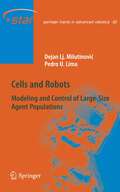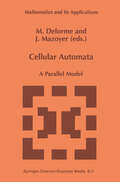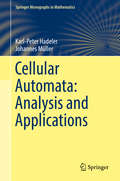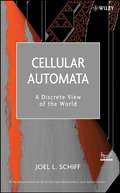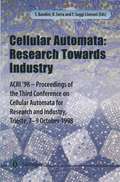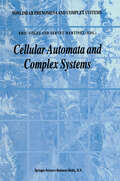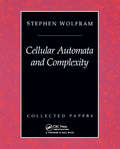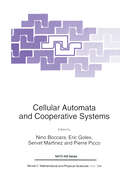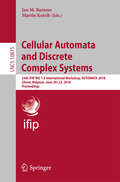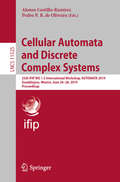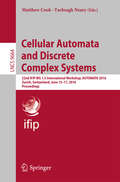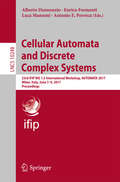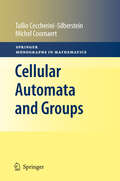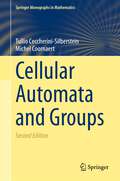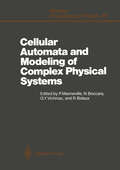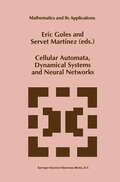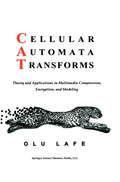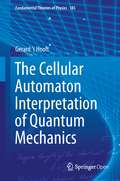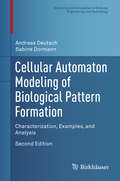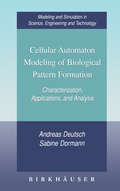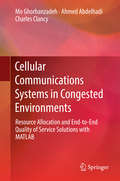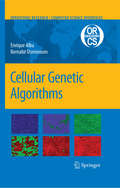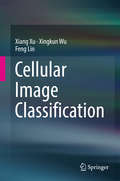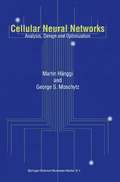- Table View
- List View
Cells and Robots: Modeling and Control of Large-Size Agent Populations (Springer Tracts in Advanced Robotics #32)
by Dejan Lj. Milutinovic Pedro U. LimaThis monograph has arisen from the multidisciplinary research extending over biology, robotics and hybrid systems theory. It is inspired by modeling reactive behavior of the immune system cell population, where each cell is considered an independent agent. The authors formulate the optimal control of maximizing the probability of robotic presence in a given region and discuss the application of the Minimum Principle for partial differential equations to this problem.
Cellular Automata: A Parallel Model (Mathematics and Its Applications #460)
by M. Delorme J MazoyerCellular automata can be viewed both as computational models and modelling systems of real processes. This volume emphasises the first aspect. In articles written by leading researchers, sophisticated massive parallel algorithms (firing squad, life, Fischer's primes recognition) are treated. Their computational power and the specific complexity classes they determine are surveyed, while some recent results in relation to chaos from a new dynamic systems point of view are also presented. Audience: This book will be of interest to specialists of theoretical computer science and the parallelism challenge.
Cellular Automata: Analysis and Applications (Springer Monographs in Mathematics)
by Karl-Peter Hadeler Johannes MüllerThis book provides an overview of the main approaches used to analyze the dynamics of cellular automata. Cellular automata are an indispensable tool in mathematical modeling. In contrast to classical modeling approaches like partial differential equations, cellular automata are relatively easy to simulate but difficult to analyze. In this book we present a review of approaches and theories that allow the reader to understand the behavior of cellular automata beyond simulations. The first part consists of an introduction to cellular automata on Cayley graphs, and their characterization via the fundamental Cutis-Hedlund-Lyndon theorems in the context of various topological concepts (Cantor, Besicovitch and Weyl topology). The second part focuses on classification results: What classification follows from topological concepts (Hurley classification), Lyapunov stability (Gilman classification), and the theory of formal languages and grammars (Kůrka classification)? These classifications suggest that cellular automata be clustered, similar to the classification of partial differential equations into hyperbolic, parabolic and elliptic equations. This part of the book culminates in the question of whether the properties of cellular automata are decidable. Surjectivity and injectivity are examined, and the seminal Garden of Eden theorems are discussed. In turn, the third part focuses on the analysis of cellular automata that inherit distinct properties, often based on mathematical modeling of biological, physical or chemical systems. Linearity is a concept that allows us to define self-similar limit sets. Models for particle motion show how to bridge the gap between cellular automata and partial differential equations (HPP model and ultradiscrete limit). Pattern formation is related to linear cellular automata, to the Bar-Yam model for the Turing pattern, and Greenberg-Hastings automata for excitable media. In addition, models for sand piles, the dynamics of infectious d
Cellular Automata: A Discrete View of the World (Wiley Series in Discrete Mathematics & Optimization #45)
by Joel L. SchiffAn accessible and multidisciplinaryintroduction to cellular automata As the applicability of cellular automata broadens and technology advances, there is a need for a concise, yet thorough, resource that lays the foundation of key cellularautomata rules and applications. In recent years, Stephen Wolfram's A New Kind of Science has brought the modeling power that lies in cellular automata to the attentionof the scientific world, and now, Cellular Automata: A Discrete View of the World presents all the depth, analysis, and applicability of the classic Wolfram text in a straightforward, introductory manner. This book offers an introduction to cellular automata as a constructive method for modeling complex systems where patterns of self-organization arising from simple rules are revealed in phenomena that exist across a wide array of subject areas, including mathematics, physics, economics, and the social sciences. The book begins with a preliminary introduction to cellular automata, including a brief history of the topic along with coverage of sub-topics such as randomness, dimension, information, entropy, and fractals. The author then provides a complete discussion of dynamical systems and chaos due to their close connection with cellular automata and includes chapters that focus exclusively on one- and two-dimensional cellular automata. The next and most fascinating area of discussion is the application of these types of cellular automata in order to understand the complex behavior that occurs in natural phenomena. Finally, the continually evolving topic of complexity is discussed with a focus on how to properly define, identify, and marvel at its manifestations in various environments. The author's focus on the most important principles of cellular automata, combined with his ability to present complex material in an easy-to-follow style, makes this book a very approachable and inclusive source for understanding the concepts and applications of cellular automata. The highly visual nature of the subject is accented with over 200 illustrations, including an eight-page color insert, which provide vivid representations of the cellular automata under discussion. Readers also have the opportunity to follow and understand the models depicted throughout the text and create their own cellular automata using Java applets and simple computer code, which are available via the book's FTP site. This book serves as a valuable resource for undergraduate and graduate students in the physical, biological, and social sciences and may also be of interest to any reader with a scientific or basic mathematical background.
Cellular Automata: ACRI’98 — Proceedings of the Third Conference on Cellular Automata for Research and Industry, Trieste, 7–9 October 1998
by Roberto Serra Furio Suggi LiveraniCellular Automata (CA), about to enter their fifties, are coming of age, seen by the breadth and quality of CA-related research carried out worldwide, as well as by the appearance of interesting applications to real world problems. The papers collected in this book, presented at ACRI 98 (Third Conference on Cellular Automata for Research and Industry -7-9 October 1998), further demonstrate the vitality of this line ofresearch. Until some years ago, a researcher interested in dynamical modelling of spatially of the partial extended systems had only one language at his disposal, namely that differential equations (PDE). These are wonderful tools to use when an analytical solution can be found or a perturbative approach can provide a good approximation of the observed phenomena. The use of digital computers has enormously expanded the explanatory and predictive power of partial differential equations by allowing one to treat cases which had been outside the scope of a "pen and pencil" approach. However, it has also opened up a way to new formalisms which are able to describe interesting phenomena and are, at the same time, well-suited for digital simulation.
Cellular Automata and Complex Systems (Nonlinear Phenomena and Complex Systems #3)
by E. Goles Servet MartínezThis book contains the courses given at the Fifth School on Complex Systems held at Santiago, Chile, from 9th .to 13th December 1996. At this school met researchers working on areas related with recent trends in Complex Systems, which include dynamical systems, cellular automata, symbolic dynamics, spatial systems, statistical physics and thermodynamics. Scientists working in these subjects come from several areas: pure and applied mathematics, physics, biology, computer science and electrical engineering. Each contribution is devoted to one of the above subjects. In most cases they are structured as surveys, presenting at the same time an original point of view about the topic and showing mostly new results. The paper of Bruno Durand presents the state of the art on the relationships between the notions of surjectivity, injectivity and reversibility in cellular automata when finite, infinite or periodic configurations are considered, also he discusses decidability problems related with the classification of cellular automata as well as global properties mentioned above. The paper of Eric Goles and Martin Matamala gives a uniform presentation of simulations of Turing machines by cellular automata. The main ingredient is the encoding function which must be fixed for all Turing machine. In this context known results are revised and new results are presented.
Cellular Automata And Complexity: Collected Papers
by Stephen WolframAre mathematical equations the best way to model nature? For many years it had been assumed that they were. But in the early 1980s, Stephen Wolfram made the radical proposal that one should instead build models that are based directly on simple computer programs. Wolfram made a detailed study of a class of such models known as cellular automata, and discovered a remarkable fact: that even when the underlying rules are very simple, the behaviour they produce can be highly complex, and can mimic many features of what we see in nature. And based on this result, Wolfram began a program of research to develop what he called A Science of Complexity."The results of Wolfram's work found many applications, from the so-called Wolfram Classification central to fields such as artificial life, to new ideas about cryptography and fluid dynamics. This book is a collection of Wolfram's original papers on cellular automata and complexity. Some of these papers are widely known in the scientific community others have never been published before. Together, the papers provide a highly readable account of what has become a major new field of science, with important implications for physics, biology, economics, computer science and many other areas.
Cellular Automata And Complexity: Collected Papers
by Stephen WolframAre mathematical equations the best way to model nature? For many years it had been assumed that they were. But in the early 1980s, Stephen Wolfram made the radical proposal that one should instead build models that are based directly on simple computer programs. Wolfram made a detailed study of a class of such models known as cellular automata, and discovered a remarkable fact: that even when the underlying rules are very simple, the behaviour they produce can be highly complex, and can mimic many features of what we see in nature. And based on this result, Wolfram began a program of research to develop what he called A Science of Complexity."The results of Wolfram's work found many applications, from the so-called Wolfram Classification central to fields such as artificial life, to new ideas about cryptography and fluid dynamics. This book is a collection of Wolfram's original papers on cellular automata and complexity. Some of these papers are widely known in the scientific community others have never been published before. Together, the papers provide a highly readable account of what has become a major new field of science, with important implications for physics, biology, economics, computer science and many other areas.
Cellular Automata and Cooperative Systems (Nato Science Series C: #396)
by N. Boccara E. Goles Servet Martínez Pierre PiccoCellular Automata and Discrete Complex Systems: 24th IFIP WG 1.5 International Workshop, AUTOMATA 2018, Ghent, Belgium, June 20–22, 2018, Proceedings (Lecture Notes in Computer Science #10875)
by Jan M. Baetens Martin KutribThis volume constitutes the thoroughly refereed proceedings of the 24th IFIP WG 1.5 International Workshop on Cellular Automata and Discrete Complex Systems, AUTOMATA 2018, held in Ghent, Belgium, in June 2018.The 10 regular papers presented in this book were carefully reviewed and selected from a total of 16 submissions. The papers highlight the major advances in the field and the development of new tools, support the development of theory and applications of CA and DCS and identify and study within an inter- and multidisciplinary context, the important fundamental aspects, concepts, notions and problems concerning CA and DCS.
Cellular Automata and Discrete Complex Systems: 25th IFIP WG 1.5 International Workshop, AUTOMATA 2019, Guadalajara, Mexico, June 26–28, 2019, Proceedings (Lecture Notes in Computer Science #11525)
by Alonso Castillo-Ramirez Pedro P. B. de OliveiraThis volume constitutes the refereed proceedings of the 25th IFIP WG 1.5 International Workshop on Cellular Automata and Discrete Complex Systems, AUTOMATA 2019, held in Guadalajara, Mexico, in June 2019.The 7 regular papers presented in this book were carefully reviewed and selected from a total of 10 submissions. The topics of the conference include deal with dynamical, topological, ergodic and algebraic aspects of CA and DCS, algorithmic and complexity issues, emergent properties, formal languages, symbolic dynamics, tilings, models of parallelism and distributed systems, timing schemes, synchronous versus asynchronous models, phenomenological descriptions, scientic modeling, and practical applications.
Cellular Automata and Discrete Complex Systems: 22nd IFIP WG 1.5 International Workshop, AUTOMATA 2016, Zurich, Switzerland, June 15-17, 2016, Proceedings (Lecture Notes in Computer Science #9664)
by Matthew Cook Turlough NearyThis volume constitutes the thoroughly refereed proceedings of the 22nd IFIP WG 1.5International Workshop on Cellular Automata and Discrete ComplexSystems, AUTOMATA 2016, held in Zurich, Switzerland, in June 2016.This volume contains 3 invited talks in full-paper length and 12 regularpapers, which were carefully reviewed and selected from a total of 23submissions. The papers feature research on all fundamental aspects of cellular automata and related discrete complex systems and deal with the following topics: dynamical, topological, ergodic and algebraic aspects; algorithmic and complexity issues; emergent properties; formal language processing; symbolic dynamics; models of parallelism and distributed systems; timing schemes; phenomenological descriptions; scientific modeling; and practical applications.
Cellular Automata and Discrete Complex Systems: 23rd IFIP WG 1.5 International Workshop, AUTOMATA 2017, Milan, Italy, June 7-9, 2017, Proceedings (Lecture Notes in Computer Science #10248)
by Alberto Dennunzio Enrico Formenti Luca Manzoni Antonio E. PorrecaThis volume constitutes the thoroughly refereed proceedings of the 23rd IFIP WG 1.5 International Workshop on Cellular Automata and Discrete Complex Systems, AUTOMATA 2017, held in Milan, Italy, in June 2017. The 14 full papers presented together with one full-length invited paper and 2 invited talk abstracts were carefully reviewed and selected from a total of 28 submissions. The papers feature research on correlated models of automata. The topics include aspects and features of such models: dynamics; topological, ergodic, and algebraic aspects; algorithmic and complexity issues; emergent properties; formal languages; symbolic dynamics; tilings; models of parallelism and distributed systems; timing schemes; synchronous versus asynchronous models; phenomenological descriptions; scientific modelling; practical applications.
Cellular Automata and Groups (Springer Monographs in Mathematics)
by Tullio Ceccherini-Silberstein Michel CoornaertCellular automata were introduced in the first half of the last century by John von Neumann who used them as theoretical models for self-reproducing machines. The authors present a self-contained exposition of the theory of cellular automata on groups and explore its deep connections with recent developments in geometric group theory, symbolic dynamics, and other branches of mathematics and theoretical computer science. The topics treated include in particular the Garden of Eden theorem for amenable groups, and the Gromov-Weiss surjunctivity theorem as well as the solution of the Kaplansky conjecture on the stable finiteness of group rings for sofic groups. The volume is entirely self-contained, with 10 appendices and more than 300 exercises, and appeals to a large audience including specialists as well as newcomers in the field. It provides a comprehensive account of recent progress in the theory of cellular automata based on the interplay between amenability, geometric and combinatorial group theory, symbolic dynamics and the algebraic theory of group rings which are treated here for the first time in book form.
Cellular Automata and Groups (Springer Monographs in Mathematics)
by Tullio Ceccherini-Silberstein Michel CoornaertThis unique book provides a self-contained exposition of the theory of cellular automata on groups and explores its deep connections with recent developments in geometric and combinatorial group theory, amenability, symbolic dynamics, the algebraic theory of group rings, and other branches of mathematics and theoretical computer science. The topics treated include the Garden of Eden theorem for amenable groups, the Gromov–Weiss surjunctivity theorem, and the solution of the Kaplansky conjecture on the stable finiteness of group rings for sofic groups. Entirely self-contained and now in its second edition, the volume includes 10 appendices and more than 600 exercises, the solutions of which are presented in the companion book Exercises in Cellular Automata and Groups (2023) by the same authors. It will appeal to a large audience, including specialists and newcomers to the field.
Cellular Automata and Modeling of Complex Physical Systems: Proceedings of the Winter School, Les Houches, France, February 21–28, 1989 (Springer Proceedings in Physics #46)
by Paul Manneville Nino Boccara Gerard Y. Vichniac Roger BidauxCellular automata are fully discrete dynamical systems with dynamical variables defined at the nodes of a lattice and taking values in a finite set. Application of a local transition rule at each lattice site generates the dynamics. The interpretation of systems with a large number of degrees of freedom in terms of lattice gases has received considerable attention recently due to the many applications of this approach, e.g. for simulating fluid flows under nearly realistic conditions, for modeling complex microscopic natural phenomena such as diffusion-reaction or catalysis, and for analysis of pattern-forming systems. The discussion in this book covers aspects of cellular automata theory related to general problems of information theory and statistical physics, lattice gas theory, direct applications, problems arising in the modeling of microscopic physical processes, complex macroscopic behavior (mostly in connection with turbulence), and the design of special-purpose computers.
Cellular Automata, Dynamical Systems and Neural Networks (Mathematics and Its Applications #282)
by E. Goles Servet MartínezThis book contains the courses given at the Third School on Statistical Physics and Cooperative Systems held at Santiago, Chile, from 14th to 18th December 1992. The main idea of this periodic school was to bring together scientists work with recent trends in Statistical Physics. More precisely ing on subjects related related with non linear phenomena, dynamical systems, ergodic theory, cellular au tomata, symbolic dynamics, large deviation theory and neural networks. Scientists working in these subjects come from several areas: mathematics, biology, physics, computer science, electrical engineering and artificial intelligence. Recently, a very important cross-fertilization has taken place with regard to the aforesaid scientific and technological disciplines, so as to give a new approach to the research whose common core remains in statistical physics. Each contribution is devoted to one or more of the previous subjects. In most cases they are structured as surveys, presenting at the same time an original point of view about the topic and showing mostly new results. The expository text of Fran
Cellular Automata Transforms: Theory and Applications in Multimedia Compression, Encryption, and Modeling (Multimedia Systems and Applications #16)
by Olurinde LafeCellular Automata Transforms describes a new approach to using the dynamical system, popularly known as cellular automata (CA), as a tool for conducting transforms on data. Cellular automata have generated a great deal of interest since the early 1960s when John Conway created the `Game of Life'. This book takes a more serious look at CA by describing methods by which information building blocks, called basis functions (or bases), can be generated from the evolving states. These information blocks can then be used to construct any data. A typical dynamical system such as CA tend to involve an infinite possibilities of rules that define the inherent elements, neighborhood size, shape, number of states, and modes of association, etc. To be able to build these building blocks an elegant method had to be developed to address a large subset of these rules. A new formula, which allows for the definition a large subset of possible rules, is described in the book. The robustness of this formula allows searching of the CA rule space in order to develop applications for multimedia compression, data encryption and process modeling. Cellular Automata Transforms is divided into two parts. In Part I the fundamentals of cellular automata, including the history and traditional applications are outlined. The challenges faced in using CA to solve practical problems are described. The basic theory behind Cellular Automata Transforms (CAT) is developed in this part of the book. Techniques by which the evolving states of a cellular automaton can be converted into information building blocks are taught. The methods (including fast convolutions) by which forward and inverse transforms of any data can be achieved are also presented. Part II contains a description of applications of CAT. Chapter 4 describes digital image compression, audio compression and synthetic audio generation, three approaches for compressing video data. Chapter 5 contains both symmetric and public-key implementation of CAT encryption. Possible methods of attack are also outlined. Chapter 6 looks at process modeling by solving differential and integral equations. Examples are drawn from physics and fluid dynamics.
The Cellular Automaton Interpretation of Quantum Mechanics (Fundamental Theories of Physics #185)
by Gerard 't HooftThis book presents the deterministic view of quantum mechanics developed by Nobel Laureate Gerard 't Hooft.Dissatisfied with the uncomfortable gaps in the way conventional quantum mechanics meshes with the classical world, 't Hooft has revived the old hidden variable ideas, but now in a much more systematic way than usual. In this, quantum mechanics is viewed as a tool rather than a theory.The author gives examples of models that are classical in essence, but can be analysed by the use of quantum techniques, and argues that even the Standard Model, together with gravitational interactions, might be viewed as a quantum mechanical approach to analysing a system that could be classical at its core. He shows how this approach, even though it is based on hidden variables, can be plausibly reconciled with Bell's theorem, and how the usual objections voiced against the idea of ‘superdeterminism' can be overcome, at least in principle. This framework elegantly explains - and automatically cures - the problems of the wave function collapse and the measurement problem. Even the existence of an “arrow of time" can perhaps be explained in a more elegant way than usual. As well as reviewing the author’s earlier work in the field, the book also contains many new observations and calculations. It provides stimulating reading for all physicists working on the foundations of quantum theory.
Cellular Automaton Modeling of Biological Pattern Formation: Characterization, Examples, and Analysis (Modeling and Simulation in Science, Engineering and Technology)
by Andreas Deutsch Sabine DormannThis text explores the use of cellular automata in modeling pattern formation in biological systems. It describes several mathematical modeling approaches utilizing cellular automata that can be used to study the dynamics of interacting cell systems both in simulation and in practice. New in this edition are chapters covering cell migration, tissue development, and cancer dynamics, as well as updated references and new research topic suggestions that reflect the rapid development of the field.The book begins with an introduction to pattern-forming principles in biology and the various mathematical modeling techniques that can be used to analyze them. Cellular automaton models are then discussed in detail for different types of cellular processes and interactions, including random movement, cell migration, adhesive cell interaction, alignment and cellular swarming, growth processes, pigment cell pattern formation, tissue development, tumor growth and invasion, and Turing-type patterns and excitable media. In the final chapter, the authors critically discuss possibilities and limitations of the cellular automaton approach in modeling various biological applications, along with future research directions. Suggestions for research projects are provided throughout the book to encourage additional engagement with the material, and an accompanying simulator is available for readers to perform their own simulations on several of the models covered in the text. QR codes are included within the text for easy access to the simulator.With its accessible presentation and interdisciplinary approach, Cellular Automaton Modeling of Biological Pattern Formation is suitable for graduate and advanced undergraduate students in mathematical biology, biological modeling, and biological computing. It will also be a valuable resource for researchers and practitioners in applied mathematics, mathematical biology, computational physics, bioengineering, and computer science. PRAISE FOR THE FIRST EDITION“An ideal guide for someone with a mathematical or physical background to start exploring biological modelling. Importantly, it will also serve as an excellent guide for experienced modellers to innovate and improve their methodologies for analysing simulation results.” —Mathematical Reviews
Cellular Automaton Modeling of Biological Pattern Formation: Characterization, Applications, and Analysis (Modeling and Simulation in Science, Engineering and Technology)
by Andreas Deutsch Sabine DormannThis book focuses on a challenging application field of cellular automata: pattern formation in biological systems, such as the growth of microorganisms, dynamics of cellular tissue and tumors, and formation of pigment cell patterns. These phenomena, resulting from complex cellular interactions, cannot be deduced solely from experimental analysis, but can be more easily examined using mathematical models, in particular, cellular automaton models. While there are various books treating cellular automaton modeling, this interdisciplinary work is the first one covering biological applications. The book is aimed at researchers, practitioners, and students in applied mathematics, mathematical biology, computational physics, bioengineering, and computer science interested in a cellular automaton approach to biological modeling.
Cellular Communications Systems in Congested Environments: Resource Allocation and End-to-End Quality of Service Solutions with MATLAB
by Mo Ghorbanzadeh Ahmed Abdelhadi Charles ClancyThis book presents a mathematical treatment of the radio resource allocation of modern cellular communications systems in contested environments. It focuses on fulfilling the quality of service requirements of the living applications on the user devices, which leverage the cellular system, and with attention to elevating the users’ quality of experience. The authors also address the congestion of the spectrum by allowing sharing with the band incumbents while providing with a quality-of-service-minded resource allocation in the network. The content is of particular interest to telecommunications scheduler experts in industry, communications applications academia, and graduate students whose paramount research deals with resource allocation and quality of service.
Cellular Genetic Algorithms (Operations Research/Computer Science Interfaces Series #42)
by Enrique Alba Bernabe DorronsoroCellular Genetic Algorithms defines a new class of optimization algorithms based on the concepts of structured populations and Genetic Algorithms (GAs). The authors explain and demonstrate the validity of these cellular genetic algorithms throughout the book with equal and parallel emphasis on both theory and practice. This book is a key source for studying and designing cellular GAs, as well as a self-contained primary reference book for these algorithms.
Cellular Image Classification
by Xiang Xu Xingkun Wu Feng LinThis book introduces new techniques for cellular image feature extraction, pattern recognition and classification. The authors use the antinuclear antibodies (ANAs) in patient serum as the subjects and the Indirect Immunofluorescence (IIF) technique as the imaging protocol to illustrate the applications of the described methods. Throughout the book, the authors provide evaluations for the proposed methods on two publicly available human epithelial (HEp-2) cell datasets: ICPR2012 dataset from the ICPR'12 HEp-2 cell classification contest and ICIP2013 training dataset from the ICIP'13 Competition on cells classification by fluorescent image analysis. First, the reading of imaging results is significantly influenced by one’s qualification and reading systems, causing high intra- and inter-laboratory variance. The authors present a low-order LP21 fiber mode for optical single cell manipulation and imaging staining patterns of HEp-2 cells. A focused four-lobed mode distribution is stable and effective in optical tweezer applications, including selective cell pick-up, pairing, grouping or separation, as well as rotation of cell dimers and clusters. Both translational dragging force and rotational torque in the experiments are in good accordance with the theoretical model. With a simple all-fiber configuration, and low peak irradiation to targeted cells, instrumentation of this optical chuck technology will provide a powerful tool in the ANA-IIF laboratories. Chapters focus on the optical, mechanical and computing systems for the clinical trials. Computer programs for GUI and control of the optical tweezers are also discussed. to more discriminative local distance vector by searching for local neighbors of the local feature in the class-specific manifolds. Encoding and pooling the local distance vectors leads to salient image representation. Combined with the traditional coding methods, this method achieves higher classification accuracy. Then, a rotation invariant textural feature of Pairwise Local Ternary Patterns with Spatial Rotation Invariant (PLTP-SRI) is examined. It is invariant to image rotations, meanwhile it is robust to noise and weak illumination. By adding spatial pyramid structure, this method captures spatial layout information. While the proposed PLTP-SRI feature extracts local feature, the BoW framework builds a global image representation. It is reasonable to combine them together to achieve impressive classification performance, as the combined feature takes the advantages of the two kinds of features in different aspects. Finally, the authors design a Co-occurrence Differential Texton (CoDT) feature to represent the local image patches of HEp-2 cells. The CoDT feature reduces the information loss by ignoring the quantization while it utilizes the spatial relations among the differential micro-texton feature. Thus it can increase the discriminative power. A generative model adaptively characterizes the CoDT feature space of the training data. Furthermore, exploiting a discriminant representation allows for HEp-2 cell images based on the adaptive partitioned feature space. Therefore, the resulting representation is adapted to the classification task. By cooperating with linear Support Vector Machine (SVM) classifier, this framework can exploit the advantages of both generative and discriminative approaches for cellular image classification. The book is written for those researchers who would like to develop their own programs, and the working MatLab codes are included for all the important algorithms presented. It can also be used as a reference book for graduate students and senior undergraduates in the area of biomedical imaging, image feature extraction, pattern recognition and classification. Academics, researchers, and professional will find this to be an exceptional resource.
Cellular Neural Networks: Analysis, Design and Optimization
by Martin Hänggi George S. MoschytzCellular Neural Networks (CNNs) constitute a class of nonlinear, recurrent and locally coupled arrays of identical dynamical cells that operate in parallel. ANALOG chips are being developed for use in applications where sophisticated signal processing at low power consumption is required. Signal processing via CNNs only becomes efficient if the network is implemented in analog hardware. In view of the physical limitations that analog implementations entail, robust operation of a CNN chip with respect to parameter variations has to be insured. By far not all mathematically possible CNN tasks can be carried out reliably on an analog chip; some of them are inherently too sensitive. This book defines a robustness measure to quantify the degree of robustness and proposes an exact and direct analytical design method for the synthesis of optimally robust network parameters. The method is based on a design centering technique which is generally applicable where linear constraints have to be satisfied in an optimum way. Processing speed is always crucial when discussing signal-processing devices. In the case of the CNN, it is shown that the setting time can be specified in closed analytical expressions, which permits, on the one hand, parameter optimization with respect to speed and, on the other hand, efficient numerical integration of CNNs. Interdependence between robustness and speed issues are also addressed. Another goal pursued is the unification of the theory of continuous-time and discrete-time systems. By means of a delta-operator approach, it is proven that the same network parameters can be used for both of these classes, even if their nonlinear output functions differ. More complex CNN optimization problems that cannot be solved analytically necessitate resorting to numerical methods. Among these, stochastic optimization techniques such as genetic algorithms prove their usefulness, for example in image classification problems. Since the inception of the CNN, the problem of finding the network parameters for a desired task has been regarded as a learning or training problem, and computationally expensive methods derived from standard neural networks have been applied. Furthermore, numerous useful parameter sets have been derived by intuition. In this book, a direct and exact analytical design method for the network parameters is presented. The approach yields solutions which are optimum with respect to robustness, an aspect which is crucial for successful implementation of the analog CNN hardware that has often been neglected. `This beautifully rounded work provides many interesting and useful results, for both CNN theorists and circuit designers.' Leon O. Chua
